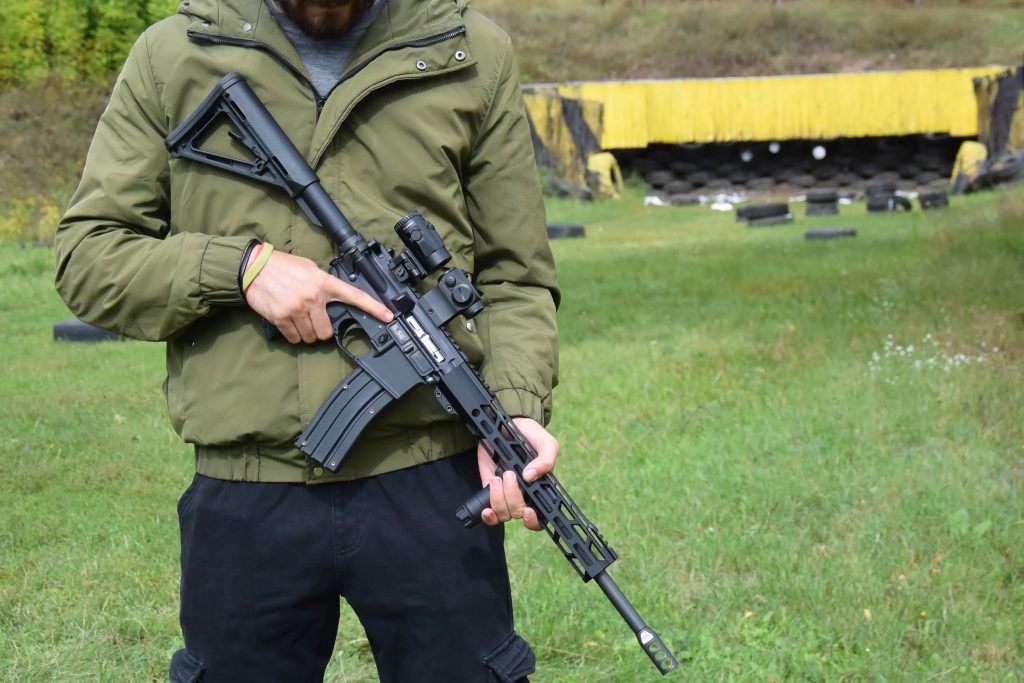
A showdown over America’s bestselling rifle is heading to the Supreme Court this fall: Gun-rights groups are asking the court to consider whether the AR-15 and other rifles described as assault weapons are deserving of constitutional protection. Should the conservative Supreme Court take up the case in its new term, it could put some of the gun-control movement’s biggest victories in jeopardy.
Nine Democratic states and Washington, D.C., have restrictions on the purchase or possession of AR-15 rifles and other firearms labeled assault weapons, with many enacted after a 20-year-old gunman used an AR-15-style rifle to kill more than two dozen first-graders and faculty at Sandy Hook Elementary School in Connecticut in 2012. The high court in a landmark 2008 opinion said law-abiding Americans have a right under the Second Amendment to protect themselves with handguns.
But justices have never said if that right extends to the AR-15.
“The court has yet to weigh in squarely on what kinds of guns can be prohibited,” said Joseph Blocher, a law professor at Duke University and co-director of the Duke Center for Firearms Law. “These cases are a lot harder than either side makes them out to be,” he said.
The court in its 2008 opinion said an individual’s right to bear arms is limited to weapons used for self-defense and other lawful purposes, and suggested that dangerous and unusual weapons designed for military use—such as the fully automatic military M16 rifle—fall outside Second Amendment protections. …
Five judges signed onto a lengthy dissent that accused the majority of disparaging the weapon and its millions of law-abiding owners.
Judge Julius Richardson, a President Donald Trump appointee who wrote the dissent, wrote that AR-15 rounds are more likely to fragment and wobble passing through walls compared with handguns, diminishing the risk to bystanders. He said the rifle’s accuracy only enhances its suitability for self-defense.
“For these reasons, law enforcement has long found the AR-15 to be an effective weapon for urban building raids and hostage situations,” he wrote. He also cited a 2021 survey of AR-15-style rifle owners about their reasons for purchasing the weapon. More than 60% said home defense was a reason.
The gun-rights groups that brought suit against Maryland have asked the Supreme Court to review the Fourth Circuit decision. They submitted a petition to the court last week that said the case was the “perfect vehicle” to resolve questions over the right to own AR-15s.
In July, the Supreme Court declined to review a similar case on Illinois’s AR-15 ban. Two justices, Clarence Thomas and Samuel Alito, urged the court to clarify what makes a weapon dangerous and unusual.
But legal observers say the Supreme Court is more likely to take up the case out of Maryland. The lower-court litigation, unlike in the Illinois case, is completed with a final judgment against the plaintiffs and amassed a more extensive evidentiary record. The Fourth Circuit ruling also carries more weight coming from the full bench instead of a typical three-judge panel.


When the primary complaint against the AR15 in home defense is another series of court cases away to tone down the noise in states that aren’t friendly towards stamp collecting let alone stamps being needed at all I can only imagine what the 2030’s will look like.
“…in states that aren’t friendly towards stamp collecting…”
That’s being actively worked on, chill and maintain…
I said 2030’s no crazy rush, besides have a lot of other work to do first.
“But justices have never said if that right extends to the AR-15.”
Well, they actually did and as the 2A does, by use of ‘arms’ which means the same today in today’s definitions as it did when the 2A was ratified which is basically ‘anything that can be used for defense or offense’. For example; Today the word “arms” refers collectively to offensive or defensive weapons. The word’s meaning has changed little since it was first used seven hundred years ago. It’s definition has never restricted civilian use of military or non-military weapons, including when the Second Amendment was written, approved, and ratified.
But what did the word “arms” mean at the time the 2A was ratified? It meant then just what it means in today’s definitions, basically, ‘anything that can be used for defense or offense’ and that includes firearms semi-auto or not, AR-15’s or not, even 30 round or larger magazines. Despite the anti-gun claim that an AR-15 is not suitable for home/self defense thus not covered under the 2A, there are literally hundreds of examples that show otherwise and the 2A in text, and when it was ratified and today, still does not confine ‘arms’ to that which is only suitable for self-defense like the anti-gun want it to say
The AR-15 is not a military weapon and never has been. The original design was a scaled down version of the AR-10, and was intended for the civilian market as a semi-auto ‘sporting’ rifle. It wasn’t actually created by Stoner as his rendition came later after that scale down design. The original design scale down was by Jim Sullivan. Later, Stoner took that and made modifications and design changes to the original civilian scale down design to suit military purposes thus creating a new design but still in the same design series cycle of Armalite at the time which was rifle design cycle 15 thus the AR-15 designation meaning ‘Armalite Rifle 15’. It unfortunately still carried the AR-15 designation not because it was a military only design but simply because it was done in the same design cycle. Thus there were actually two different AR-15 designs, with the original being intended for the civilian market and the other, the Stoner design, being derived from the civilian version design. So in realty, contrary to anti-gun and other sources, the AR-15 was actually intended to be and was designed as a civilian rifle. In other words it always was for the civilian market. The Stoner design was what Colt got in the patent purchase, Colt took that and did a redesign and marketed their redesign to the military and it later became designated the M-16 and did a civilian version and marketed that to the commercial civilian market. But here again that unfortunate use of the AR-15 designation… part of the agreement with Colt to buy the patent was that the AR-15 designation would be carried forth by Colt and this resulted in some early models of the rifles sold to the military and civilian markets having the AR-15 designation on them thus because it was sold to the military with that designation it started to become known as a ‘military rifle’ and actually it never was.
The reason Heller said said law-abiding Americans have a right under the Second Amendment to protect themselves with handguns is because Heller was about handguns, but also Heller did not exclude other firearms and say ‘only handguns’.
And everyone seems to forget about the U.S. Supreme Court’s Miller decision in the 1930s where the Court explicitly stated that a firearm has to be useful for the militia or military to enjoy Second Amendment protection.
Needless to say, so-called “modern sporting rifles” are useful to both the militia and the U.S. military. (Yes, the U.S. military does NOT use AR-15s. That does not matter. What matters is if AR-15s would be useful if the U.S. military decided to use them. And the obvious answer is yes.)
“…the U.S. Supreme Court’s Miller decision in the 1930s where the Court explicitly stated that a firearm has to be useful for the militia or military to enjoy Second Amendment protection.”
All the more reason to nuke the ‘Hughes Amendment’ as being unconstitutional.
Re-open the registry, ‘switches’ for all the good girls and boys!